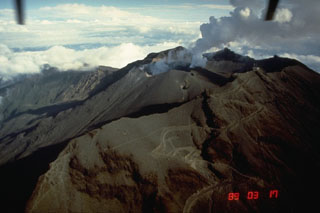Report on Galeras (Colombia) — May 1999
Bulletin of the Global Volcanism Network, vol. 24, no. 5 (May 1999)
Managing Editor: Richard Wunderman.
Galeras (Colombia) Low seismicity and variable Radon-222 fluxes during March and April
Please cite this report as:
Global Volcanism Program, 1999. Report on Galeras (Colombia) (Wunderman, R., ed.). Bulletin of the Global Volcanism Network, 24:5. Smithsonian Institution. https://doi.org/10.5479/si.GVP.BGVN199905-351080
Galeras
Colombia
1.22°N, 77.37°W; summit elev. 4276 m
All times are local (unless otherwise noted)
During March and April 1999, seismic activity continued at low levels, similar to those reported in previous months (BGVN 24:02). The biggest source of seismic energy release, 2.1 x 1015 ergs, was associated with volcano-tectonic (VT) events attributed to fracturing. In total, 75 VT earthquakes were registered, located at depths between 0.4 and 20 km below the summit. The largest event, on 3 April, had a magnitude of 2.7 and was located SW of the volcano. During this two-month period the sum of the seismic energy released by 46 long-period events and 27 tremor episodes amounted to 9.8 x 1013 ergs. Radon-222 emissions at four stations located around the volcano measured between 23 and 3,608 pCi/l, values similar to those seen in previous months.
Geological Summary. Galeras, a stratovolcano with a large breached caldera located immediately west of the city of Pasto, is one of Colombia's most frequently active volcanoes. The dominantly andesitic complex has been active for more than 1 million years, and two major caldera collapse eruptions took place during the late Pleistocene. Long-term extensive hydrothermal alteration has contributed to large-scale edifice collapse on at least three occasions, producing debris avalanches that swept to the west and left a large open caldera inside which the modern cone has been constructed. Major explosive eruptions since the mid-Holocene have produced widespread tephra deposits and pyroclastic flows that swept all but the southern flanks. A central cone slightly lower than the caldera rim has been the site of numerous small-to-moderate eruptions since the time of the Spanish conquistadors.
Information Contacts: Observatorio Vulcanológico y Sismológico de Pasto (OVSP), Carrera 31, 18-07 Parque Infantil, PO Box 1795, Pasto, Colombia (URL: https://www2.sgc.gov.co/volcanes/index.html).

